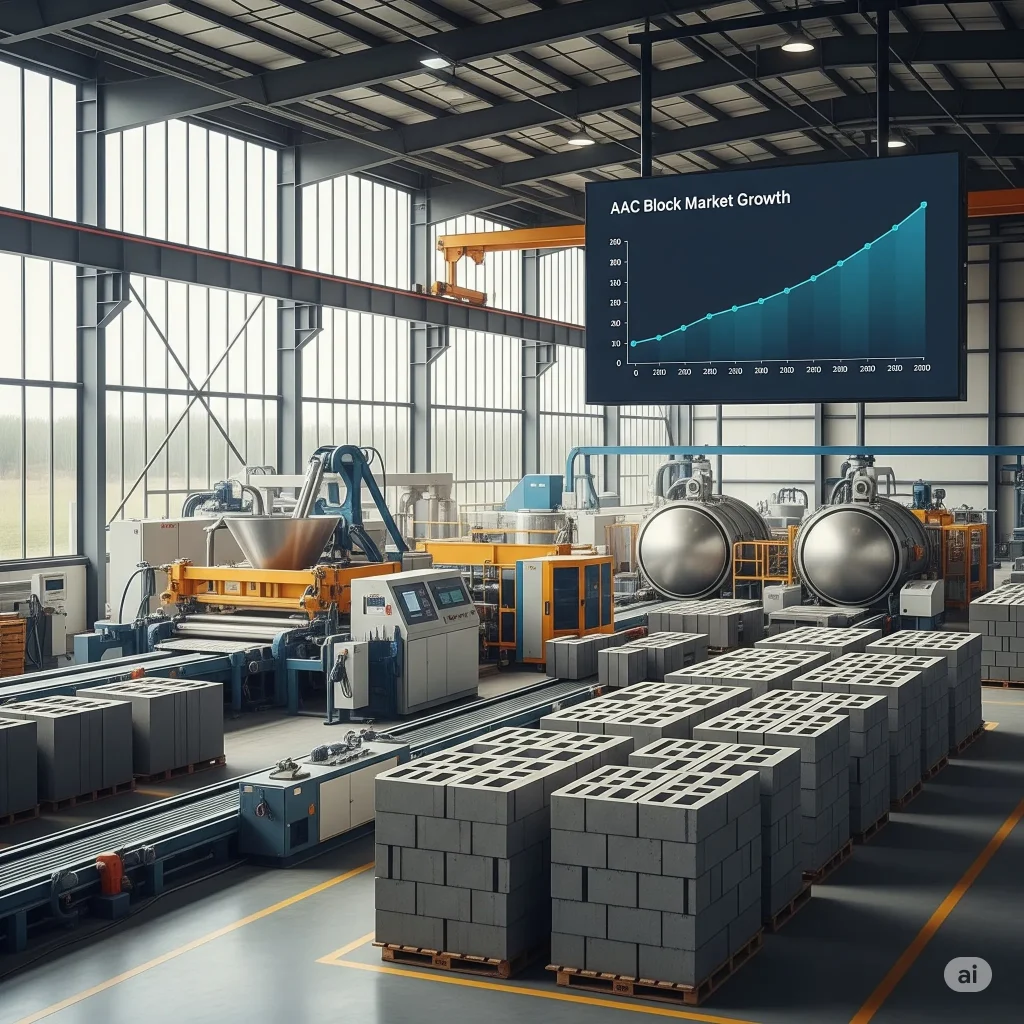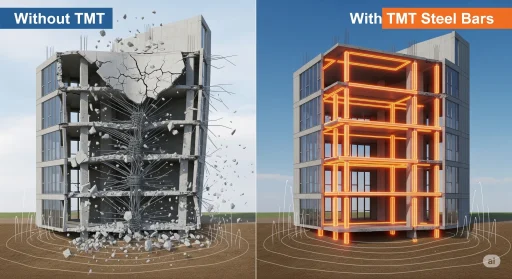The construction world is changing fast, and now everyone governments, builders, and buyers want to use green materials. One standout option is Autoclaved Aerated Concrete (AAC), a lightweight, planet-friendly, and tough alternative to regular clay bricks. Because AAC blocks manufacturing offer great insulation, resist fire excellently, and are simple to handle, they are quickly becoming the go-to choice for homes, offices, and factories.
For startup founders keen to step into the manufacturing side of the building boom, making AAC blocks is a smart choice. The steadily increasing demand for construction materials meets the soaring interest in eco-friendly products. This how-to guide carefully walks you through everything you need to know about the AAC block business, including market demand, key players, how to make the blocks, and the industry’s expected growth.
Exploring the AAC Block Market
The first AAC blocks rolled off a Swedish factory line in the 1920s as a slimmer, lighter option to old-fashioned bricks. Nowadays, factories on every continent produce them, and you’ll find AAC in homes, schools, and factories across Europe, Asia, and the Middle East. By 2030, the world’s AAC block market is expected to zoom past USD 31 billion, growing at a steady clip of about 7 percent a year.
The AAC block industry in India is taking off like never before. In 2022, the market hit about USD 8.2 billion, and experts believe it could reach USD 18 billion by 2030. Why? Rapid urbanization, government programs for affordable housing, and growing demand for eco-friendly building materials are the driving forces.
Related: How to Profit from the Growing AAC Blocks Manufacturing
India AAC Block Market Forecast
| Year | Market Size (USD Billion) | Growth Rate (%) | Key Drivers |
| 2022 | 8.2 | – | Baseline demand |
| 2023 | 9.1 | 11% | Real estate expansion |
| 2024 | 10.2 | 12% | Green construction demand |
| 2025 | 11.5 | 13% | Affordable housing push |
| 2026 | 13.0 | 13% | Government incentives |
| 2027 | 14.8 | 14% | Smart city projects |
| 2030 | 18.0 | 10-12% CAGR | Sustainable infrastructure |
Looking at these numbers, AAC blocks manufacturing is not just about making another building material. It is a cornerstone for building Indian cities in a greener, smarter way.

Why Entrepreneurs Should Think About AAC Blocks Manufacturing
Entrepreneurs have a strong case for jumping into the AAC block business. Compared to traditional red bricks, AAC blocks are lighter, cutting down the weight on structures. That means less steel and cement are required, saving costs. The superior thermal insulation of these blocks keeps indoor spaces comfortable and lowers energy bills, making them a hit for houses and offices alike.
Builders see quicker schedules when using AAC blocks manufacturing because their even size and smooth finish cut down on plaster and mortar expenses. Beyond speed, the blocks bring extra perks: they can’t burn, they resist pests, and they block noise surprisingly well. Plus, when made with stuff like fly ash, they recycle waste while cutting carbon footprints. That double win fits perfectly with the green and energy-saving building trend that’s gaining pace worldwide. Manufacturers who move into this tech can scale up and stay steady for the long term.
Check out our Books on Cement, Asbestos, Ceramics, Bricks, Limestone and Construction Materials Manufacturing Technology
Step-by-Step Guide to Starting AAC Blocks Manufacturing
Step 1: Conduct Market Research
Kick things off with a deep look at the building market in the area you pick. Find out which places are using AAC the most likely, that’s the city centers, where big housing and infrastructure projects are still in motion. Your market search should also answer key questions: What are other block plants up to? What do they charge locally? What do builders want in terms of size, finish, and delivery time? Get a feel for how materials move in and out of the region. Collecting this data early helps you shape a plan that’s built to fly, rather than one that needs big changes later.
Step 2: Know the Raw Materials and Inputs
AAC blocks rely on specific raw materials: fly ash (or finely ground sand), cement, lime, gypsum, and aluminum powder. Fly ash is the ash left over from burning coal in power plants. Because it’s a by-product, it’s affordable and friendly to the environment. Meanwhile, aluminum powder is the secret ingredient that makes the blocks so light. It combines with the other materials to form tiny bubbles, creating a low-density, airy structure.
Step 3: Follow the Manufacturing Flow
The production process for AAC blocks is both scientific and high-tech, turning simple ingredients into strong, lightweight units.
- Prepare the Raw Ingredients: Fly ash or sand is finely milled until all the grains are the same size. This ensures even mixing later.
- Mix and Measure: In a high-precision mixer, the ground fly ash, cement, lime, gypsum, water, and a tiny amount of aluminum powder are combined. This mixture is dosed in the exact quantities needed. The aluminum powder talks with the lime, releasing hydrogen gas that generates the tiny air pockets essential for insulation.
- Pour and Get Ready to Cure: The slurry flows into steel molds. Right there, it expands and begins to harden into a light cake.
- Slice to Size: Once the mixture is semi-firm, high-speed wire cutters trim the blocks to final size. The wires create clean, straight edges for uniform final products.
- Steam-Bake in the Autoclave: The molds of fresh blocks move to large steel autoclaves. They are sealed and cooked with steam at high pressure. This phase makes the blocks super strong, adding heat resistance and thermal insulation at the same time.
- Finish and Ship: Cooled blocks are pulled from the autoclave, stacked on pallets, wrapped for protection, and loaded on trucks. From the factory, they head straight to builders and wholesalers who can’t wait to use them.
This process scales effortlessly and can be automated to boost speed and keep quality uniform.
Related: A Successful Business Idea for AAC Blocks and Panels
Step 4: Identify Your Targets
Target customers for AAC blocks are real estate developers, government contractors, single homeowners, infrastructure outfits, and institutions building on a large scale. Forge ties with real estate groups, construction companies, and material distributors for steady demand. Entrepreneurs shouldn’t miss the chance to create buzz in semi-urban and rural areas, where AAC is just starting to make inroads.
Step 5: Meet Quality Standards
To be accepted in the building world, AAC blocks must pass both national and international benchmarks, like IS 2185 in India. Essential quality checks include a compressive strength test, dimensional precision evaluations, and fire resistance confirmation. Certification instills confidence in customers and ticks the compliance box for big projects.
Step 6: Build a Distribution Network
To widen your market, set up a network of wholesalers, construction material suppliers, and dedicated sales teams. Team up with logistics companies for timely project-site deliveries. Use digital marketing to spotlight the blocks’ eco-friendly and cost-boosting perks.
Global Players in AAC Blocks Manufacturing
AAC (Autoclaved Aerated Concrete) block manufacturing has evolved into a well-established global industry. A handful of leading firms demonstrate the technology’s scalability and broad acceptance. Below are some of the most influential manufacturers:
| Company Name | Country of Origin | Key Highlights |
| Xella Group | Germany | Largest AAC producer in Europe with Ytong and Hebel brands. |
| H+H International A/S | Denmark | Major European producer focused on sustainable construction. |
| Aercon AAC | United States | North America’s leading AAC manufacturer, specializing in energy-efficient solutions. |
| ACICO Industries | Kuwait | Dominant AAC producer in the Middle East with diverse operations. |
| Biltech Building Elements | India | One of the largest manufacturers in the Asian AAC market. |
| Magicrete Building Solutions | India | Key producer with extensive nationwide distribution. |
| AKG Gazbeton | Turkey | Leading manufacturer with abundant export operations. |
| CSR Hebel | Australia | Renowned for lightweight building solutions and AAC technology. |
| UltraTech Cement Ltd. | India | Part of the Aditya Birla Group, includes AAC blocks in its broad building solutions. |
This diverse group highlights the technology’s acceptance from Europe and North America to the Middle East and Asia. Emerging firms can look to their strategies and growth journeys for practical guidance.
Challenges and Opportunities for Entrepreneurs
The market is promising, but would-be founders still face hurdles. One of the biggest issues is the low awareness of AAC blocks among small contractors, especially in rural areas where standard bricks still rule. There’s also the fact that AAC blocks are porous and demand special care during shipping. Entrepreneurs will need sharp logistics and training programs for end-users to clear these hurdles.
At the same time, real prospects are opening up. Projects backed by the government, such as housing schemes and smart city plans, are leaning toward AAC and offering steady demand. The rise in sustainable building practices boosts interest, further expanding the market. Export doors are also ajar, particularly in African and South Asian countries that are looking to India for AAC block supplies.
Future Outlook of AAC Block Manufacturing
The AAC block industry is on a growth trajectory aligned with urbanization, population growth, and sustainability goals. Over the next decade, India is projected to add nearly 400 million new urban residents, creating massive demand for housing and infrastructure. AAC blocks will be central to meeting this demand due to their energy efficiency and cost benefits.
Globally, as countries commit to reducing carbon emissions in construction, AAC blocks will gain even greater prominence. With automation and technology adoption, production costs are expected to decrease, making AAC even more competitive compared to traditional bricks. For startups, the next five years are a crucial window to enter this industry and establish market presence.
Role of NIIR Project Consultancy Services (NPCS)
For entrepreneurs navigating the complexities of AAC block manufacturing, professional guidance can make a significant difference. NIIR Project Consultancy Services (NPCS) prepares Market Survey cum Detailed Techno Economic Feasibility Reports that provide in-depth insights for startups. These reports include the full manufacturing process, raw material requirements, plant layout, and financials. NPCS supports entrepreneurs in assessing the feasibility of setting up new industries and building a roadmap for profitable business ventures.
Find Best Idea for Yourself With our Startup Selector Tool
Conclusion
Starting an AAC block manufacturing business is one of the most promising ventures for entrepreneurs entering the industrial sector. With the dual advantages of rising market demand and environmental sustainability, AAC blocks are not just a product but a solution to modern construction challenges. From conducting market research and understanding raw materials to adopting advanced manufacturing processes and building strong distribution networks, entrepreneurs can successfully establish themselves in this sector.
The global presence of established AAC block manufacturers highlights the scalability of this business model. For startups, India offers the added advantage of supportive government policies, abundant raw materials, and rapidly growing construction demand. By leveraging consulting expertise and focusing on quality and sustainability, entrepreneurs can build thriving businesses in AAC block manufacturing that contribute to both profitability and greener infrastructure.







